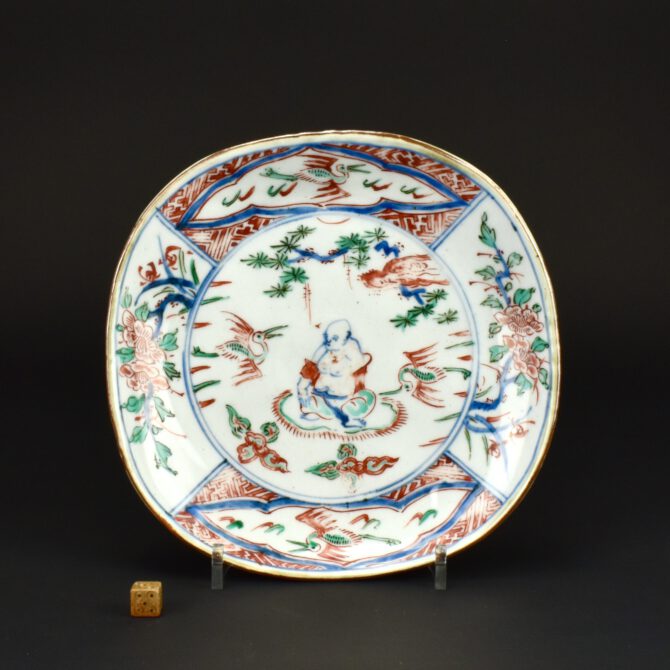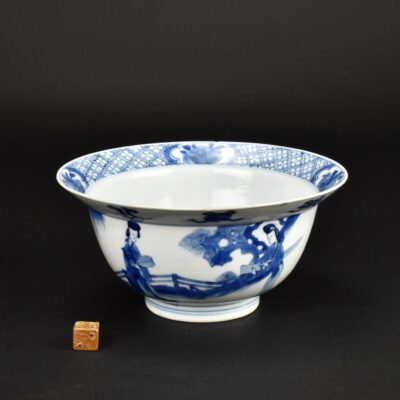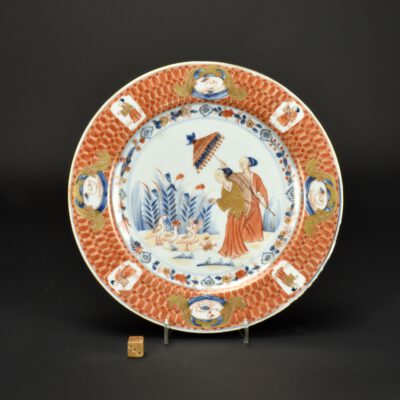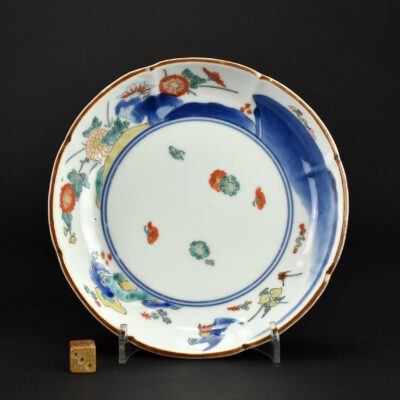
A Transitional Porcelain Ko-akai Enamelled Dish Made for the Japanese Market
Chongzhen Period 1628 - 1644
A Transitional Porcelain Ko-akai Enamelled Dish Made for the Japanese Market, Jingdezhen Kilns, Ming Dynasty, Chongzhen Period 1628 - 1644. This Ming dish Ko-akai Ming porcelain is thickly potted and so it is rather heavy. The dish was decorated in underglaze blue and fired, then it was enamelled and given its finial firing. The glaze is blue grey. This serving dish Mukozuke (literally meaning beyond server) was made in for the Kaiseki meal that accompanies the Japanese tea ceremony. Painted in underglaze cobalt blue with green, iron-red, and black. The central scene in the well depicts Budai (Hotei in Japanese), he is a Chinese deity. His name means `Cloth Sack` and comes from the bag that he carries. According to Chinese tradition, Budai was an eccentric Chinese Zen monk who lived during the 10th Century. Bearing in mind the long connection between Zen Buddhism and the Japanese tea ceremony, it is not surprising Budai takes center stage in this design. He sits on a fringed rug with the moon or sun above with pine and a cloud. Two phoenixes flank him, one of which has its head upside down. Below Budai are two ruyi-heads among stylised clouds. The border consists of two facing panels of flowering peony with orchid, the other two facing pales have a cartouche with flying phoenix against a red diaper ground. As with many pieces of Ming porcelain made for the Japanese market, this dish is deliberately made in a way that fits the Wabi-sabi aesthetic of delight in imperfection and accident. The shape is uneven, it is roughly made or should I say made with spirit and energy. The painting is free, there are imperfections such as tiny flecks of the iron red paint left on the surface. The back has allot of kiln grit within the footrim, the rim has been dressed with an iron oxide glaze.
This Ming porcelain comes with a Tomobako box with a piece of Japanese paper with writing and ten red seals. Tomobako storage boxes are an important part of Japanese culture, often made of cedar or paulownia wood. To hold the box and the lid closely together a string is used, which is knotted above the lid in a slipknot (himokake 紐掛け). It was once round, but since the beginning Edo Period (1603-1868) a flat cotton string (sanada-himo 真田紐) is more common. It took me a while to get this right, if you get it wrong it might seem safe but isn't. Unlike many countries, traditional Japanese buildings had few if any solid walls, so shelves as we know them were not used. Precious objects were kept in boxes for a number of reasons. Western displays with objects on permanent show mean the brain starts to dismiss the objects, they just blend into their environment and become unseen. In Japan, tomobako would be opened among invited friends, they could be looked at with fresh eyes, shared and passed around. A far more down to earth reason is the extreme danger of volcanoes in Japan.
See Below For More Photographs and Information.
View details
-
Oriental & European CeramicsEstablished in 1980
 ALL ITEMS FOR SALE
ALL ITEMS FOR SALE -
 CHINESE CERAMICS
CHINESE CERAMICS -
 JAPANESE and EUROPEAN CERAMICS
JAPANESE and EUROPEAN CERAMICS -
 Recently Added
Recently Added -
 Sold Archive
Sold Archive
Buying Antique Ceramics From Robert McPherson Antiques
Read more
Robert McPherson Antiques
Specialist in Oriental Ceramics
WELCOME TO OUR WEBSITE We hope you find it easy to navigate and enjoy looking at what we have on offer. As well as the objetcs we have for sale, we offer a selection of scholary pages to inform you about the different subjects concerning Oriental Ceramics. We pride ourselves on offering genuine pieces of rare and unusual Chinese and Japanese porcelain and pottery. Everything we sell is guaranteed to be in the condition we describe it as on the website and on the invoice. If you have any questions please get in contact with us. We also have a mailing list that you can subscribe to. You will receive a newsletter when the website is updated. Regards, Robert McPherson.
About us